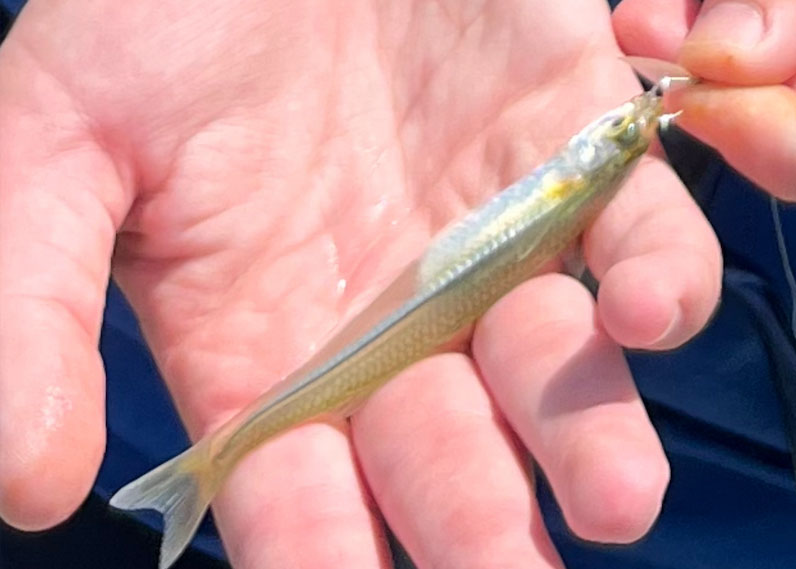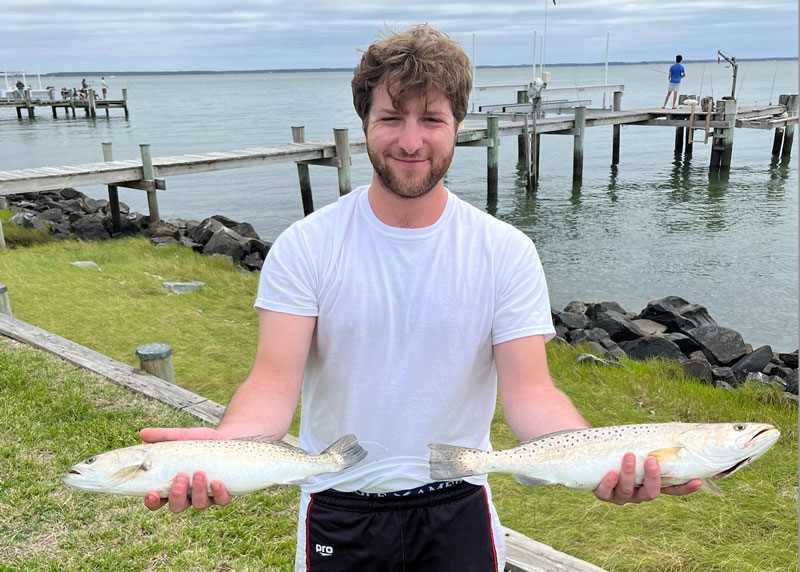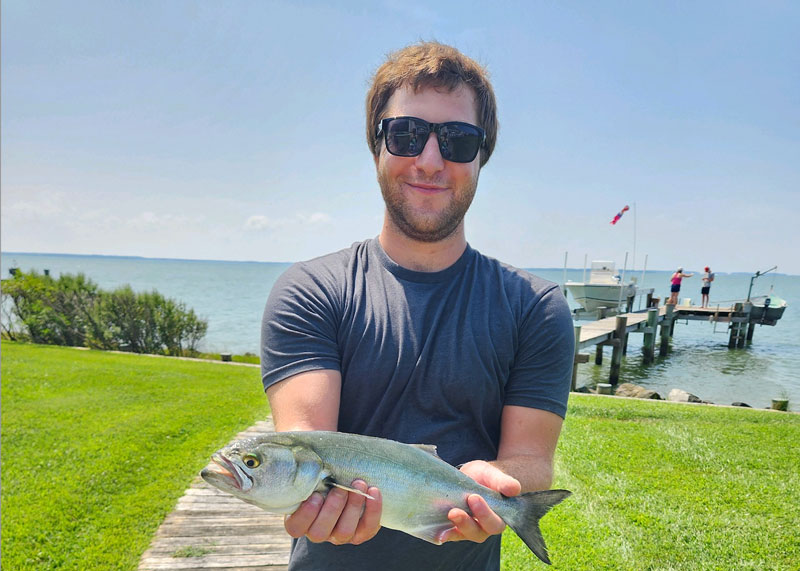It was Memorial Day weekend on the mouth of the Choptank River, and the fishing was unusually quiet. The water was so clear you could make out every little shell and pebble on the sandy bottom. I grabbed a sabiki rig tipped with Fishbites and dropped it down, hoping to catch some live bait. I watched in the crystal clear water as my hooks were swarmed. Not by spot, nor croaker. Not even by perch.

They were Atlantic silversides – but the little guys couldn’t quite fit the Fishbites in their tiny mouths. I glanced over at the boulders lining the shoreline and… eureka!
Periwinkles, hundreds of them. With spot apparently out of the question for bait and a last-ditch effort needed, I climbed down on the wet rocks and gathered a handful of these snails. I smashed two of them open and threaded each one onto the sabiki hooks. Down went my offering, and I watched the tiny fish attack in piranha-like fashion.
I reeled up, and two Atlantic silversides were dangling from my hooks. Finally, some live bait. I stuck a circle hook through one of them and casted him off the end of the pier. Within minutes I had a strike, and I managed to wrangle in a thick speckled trout. My fellow anglers and I took advantage of this discovery and landed half a dozen specks in the next hour.

It was a spectacular surprise, and I continue using silversides to this day. But it seems like very few other anglers in the Chesapeake region have adopted this strategy. Is this just a well-kept secret, or has nobody figured it out yet? Either way, we constantly see schools of specks and bluefish and rockfish chase these little guys. So, why not utilize Atlantic silversides as live bait and catch more fish?
How to Catch Atlantic Silversides
Atlantic silversides are abundant in the Chesapeake Bay and relatively easy to catch. Most bait shops in our region don’t sell them, so yes, you’ll have to catch them. The two most effective ways to do so are with a sabiki rig or a cast net.
A sabiki rig consists of a barrel swivel followed by a number of tiny hooks or flies attached to the same line with a weight at the end. Different states have varying laws regarding how many hooks may be used on a sabiki rig, so be sure to check your local regulations. You can either buy a sabiki rig that has only a legal number of hooks, or you can buy longer ones with more hooks and cut them into separate rigs, which I prefer; it’s more bang for your buck.
Hook size is extremely important when selecting a sabiki rig for Atlantic silversides. These rigs come in all shapes and sizes, so narrowing it down might be overwhelming. Let me help you out with a simple word of advice– go as small as you can. Try to avoid the standard Chesapeake sabiki rig when going after these tiny baitfish. The rigs work wonderfully for spot and perch, but usually the hooks won’t be small enough for your silversides.
Choosing the right weight is also fairly straightforward. The key is making sure your rig hits the bottom quickly and stays there while simultaneously being able to maintain tension in your line. This will allow for the baits to suspend in the water column instead of laying on the bottom. You’ll also be able to feel the tiny tick tick of the silversides grabbing your offering. A quarter ounce to one ounce weight will work well; just match it to the water depth and current strength.

The best bait for Atlantic silversides is snails, hands down. Marsh periwinkles– those white and grey colored shell dwellers you find all over rocks, grass, and pilings– are likely the species you will come across most in the Chesapeake Bay region. Fishbites, bloodworms, and other tiny cut baits will entice silversides but likely be ripped off the hook before a fish is secured. Go with snails. Crush the shell with a rock, and pull the little slug-shaped meat out. Before you put it on the hook, find the suction bit of the periwinkle. It will be darker in color and easy to spot. This part of the critter’s body is extremely tough and will make sure the bait stays securely on the hook. Push the point of the hook through this piece of flesh, drop down your sabiki, and slowly reel when you feel that little nibble.
Cast nets are also an effective way to catch Atlantic silversides. They aren’t as easy to throw as they look. It will take a lot of practice. But once you’ve got it down and see a school of the little guys swim by, you can catch yourself a whole bunch. Again, when fishing for such small species, you want to use small gear. Quarter inch mesh size is the way to go.
Both methods work great for securing yourself some Atlantic silversides for bait, however oftentimes the cast net will haul in other species as bycatch, which takes time to sort through. Also, throwing a cast net into a big school of silversides will likely yield more bait than you can use, which can unnecessarily cause injury or death to a lot of little fish. Either will work, but I recommend the sabiki rig.
How to Fish Atlantic Silversides
The best way to fish an Atlantic silverside is on a Carolina rig. A Carolina rig is made up of a sliding egg sinker on the mainline followed by a barrel swivel and leader with a hook on the end. The size weight you choose for your rig is, again, dependent on water depth. I typically fish silversides in five to eight feet of water, so my choice of weight is either a half ounce or one ounce. Once that weight is slid onto the mainline and a barrel swivel is attached, it’s time to select a leader. Fluorocarbon is the material to go with, at least 20-pound test. Lots of toothy species like speckled trout and bluefish will come for your offering, so having some extra durability while also presenting a nearly invisible line for the shy ones is important. In terms of length, I like to go with three to four feet, but in deeper water a longer leader may be necessary. The long leader will give your silverside plenty of room to swim around, while the weight prevents him from only swimming on the surface. At the end of your leader, tie a size 1/0 circle hook.
Now you’re ready to put a bait on the hook. Choosing where to hook your Atlantic silverside is the same as spot. Hook him through the nose or mouth when you want him to swim up, and go through the back when you want him to swim down. Remember, go between the dorsal and tail in slower water, and hook him between the dorsal and head in stronger current. I fish from a pier or the shoreline without electronics, so I’ll typically assess the current and toss out one mouth-hooked and another bait hooked through the back. Whichever gets bit tells you where in the water column the fish are feeding, and you’ll know how to rig the rest of the silversides you cast.
And there you have it – hold onto your rod or stick it in a holder, wait for a strike, and hold on tight!
-By Adam Greenberg